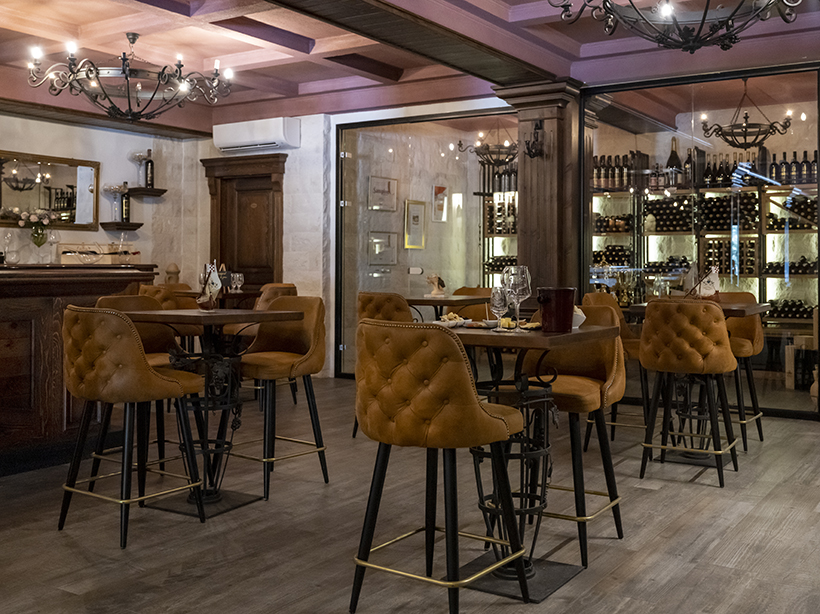In the first part of this series, I introduced you to Croatia’s Pelješac peninsula and Plavac Mali, the red wine varietal for which it’s known. This time, I’ll take you to three of the region’s most famous wineries: Korta Katarina, Grgić, and Matuško. Or, as I like to call them, the Yankee, the Centenarian, and the Donkey.
The Yankee: Korta Katarina
If you want to stay on Pelješac in style, the town of Orebić is home to the peninsula’s only Relais & Chateaux hotel, one of five in the whole of Croatia: Villa Korta Katarina. “Standing proudly like an oppidum atop a hill, Villa Korta Katarina rises above the Adriatic and surrounding vineyards with undeniable majesty,” boasts their brochure. “The Villa Katarina, among Croatia’s poshest hospitality offerings, ratchets up the luxe factor for Mediterranean rentals—big time,” assures Forbes. The establishment is the brainchild of billionaires Lee and Penny Anderson (korta means courtyard in the Dalmatian dialect, and Katarina is the Croatian spelling of their daughter’s name). The couple fell in love with the region in 2001 while traveling in post-war Croatia with a non-profit organization providing humanitarian aid to the people of Bosnia-Herzegovina. Being billionaires, they decided to purchase what was then the Rivijera hotel on the Adriatic Sea. Being avid oenophiles, they also wanted to build a winery, and began buying small parcels in the Dingač and Postup appellations. In 2006, Korta Katarina released its first vintage, and guests can now enjoy the property’s production at the tasting room or the wine bar on the premises.
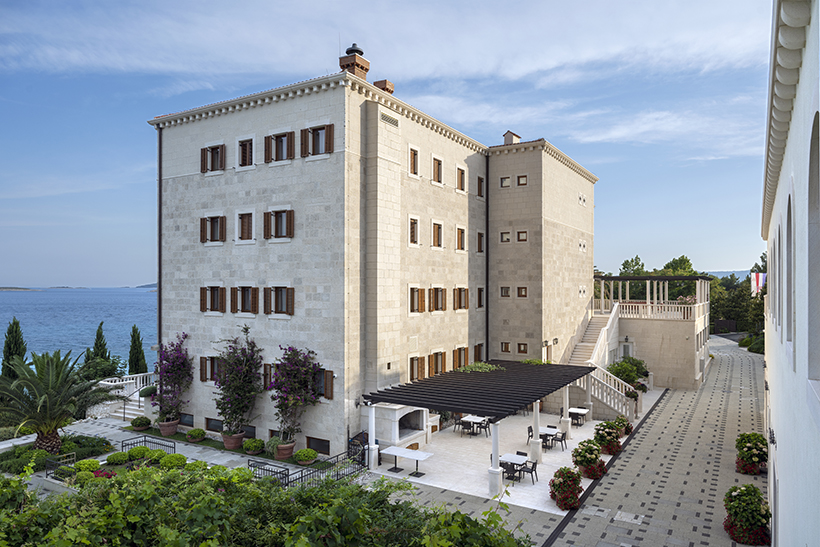
You might be thinking, “So a couple of billionaire from Minnesota bought themselves a hotel by the sea and built a trophy winery to satisfy their love of wine – big deal.” And this sure sounds like a recipe for nondescript wine, where marketing, excessive aging in new oak, and a pretty view compensate for the limited craft of some disinterested winemaker-for-hire.
Yet this couldn’t be further from the truth. Korta Katarina’s wines have received silver and bronze medals at the Decanter World Wine Awards, along with high ratings from several publications. And they sure didn’t pick the worst vineyards. If you get to Korta Katarina on foot via the promenade along the beach, you can enjoy magnificent views of the Postup microregion. There’s one parcel that will probably draw your eye, as it’s located much higher up the mountains than the others, all by itself in a kind of small bowl. “Yeah, we own that vineyard,” says Goran Tanić, our host for the visit and tasting. All of KK’s reds are Plavac Mali, and all of them are made with 50% grapes from Postup and 50% from Dingač. I think this is the only winery we visited that makes all of their Plavac reds using 100% appellation grapes. As for whites, the winery uses mostly Pošip and purchases carefully selected berries from the Čara area of nearby Korčula Island (probably the most reputable growing region for that varietal).
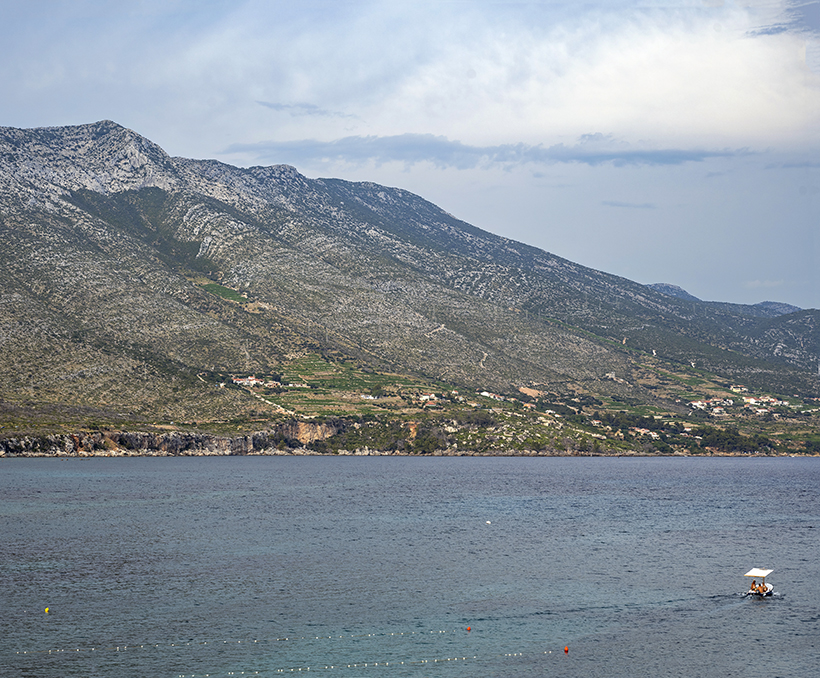
Since Korta Katarina also operates a fine dining restaurant, during our visit we opt to combine our wine tasting with dinner. Here are the highlights.
We start the meal with a sparkling wine made with Rukatac. Normally, Rukatac is a table wine, the kind that locals mix with sparkling water in the summer. In a bougie nod to this plebeian spritzer tradition, Korta Katarina produces a méthode champenoise. “Beautiful straw color, complex herbal aroma with fresh taste,” says the marketing spiel. I’m just happy to enjoy a refreshing drink after a day in the scorching sun, which is exactly what this wine is for.
The first dish arrives: a scallop from Ston, topped with a blue cheese sauce, shredded potato chips, and orange soy tobiko. The surprising umami-based flavor pairing actually works, and it’s complemented by a Pošip white wine partially aged in oak to accentuate the umami. The young vintage has been matured half in oaks barrels, and half in stainless steel, unlike most of the Pošips in the region, which never touch wood. The result is quite different: I taste notes of peach and pear and a hint of butter.
Next, a spring onion gazpacho with a shrimp from the nearby fishing town of Lovište, a rice chip, and garlic micro greens, is paired with “The American,” another Pošip, this one made with the best grapes from the Čara area and aged in oak for 18 months. Perhaps not surprisingly, it tastes very much like a California Chardonnay, with aromas of vanilla and brioche, and a creamy finish.
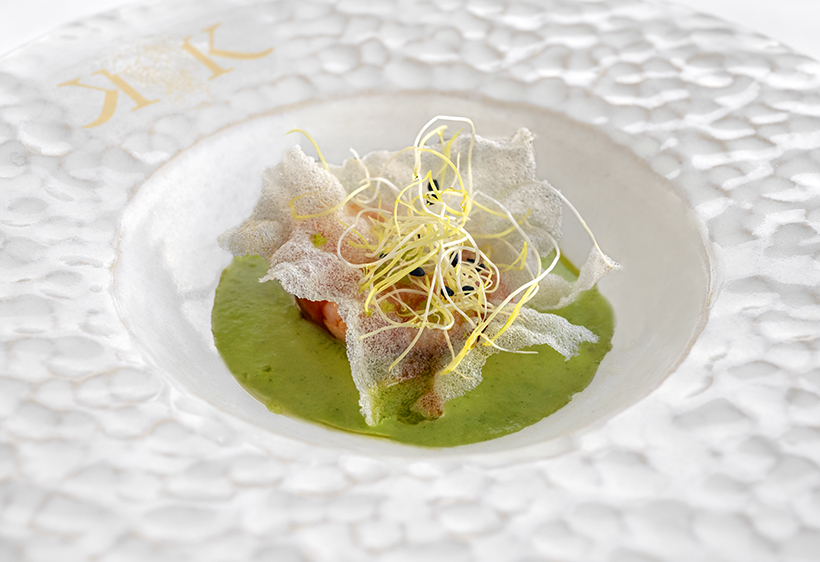
A Slavonian duck breast with sweet potatoes, pumpkin seeds, garlic cream, and green beans, brings the first Plavac Mali of the tasting: a 2013 vintage, aged for 12-15 months in barriques. The Dingač grapes provide their characteristic jammy flavor of red berries, and the Postup grapes add notes of red pepper and paprika. The duck goes very well with the wine indeed, and I am told that there are sweet potatoes growing in Croatia, albeit farther inland.
Next comes a rather busy dish: slow-cooked lamb loin (from a small farm on the peninsula) with Mediterranean herbs, asparagus, morels, beets (cooked in wine with spices), and a trio of purées (carrot, celery root, green pea). We are poured a Plavac Mali from 2012, aged for 18 months in barriques, a winemaker selection that’s similar to but more concentrated than the previous red.
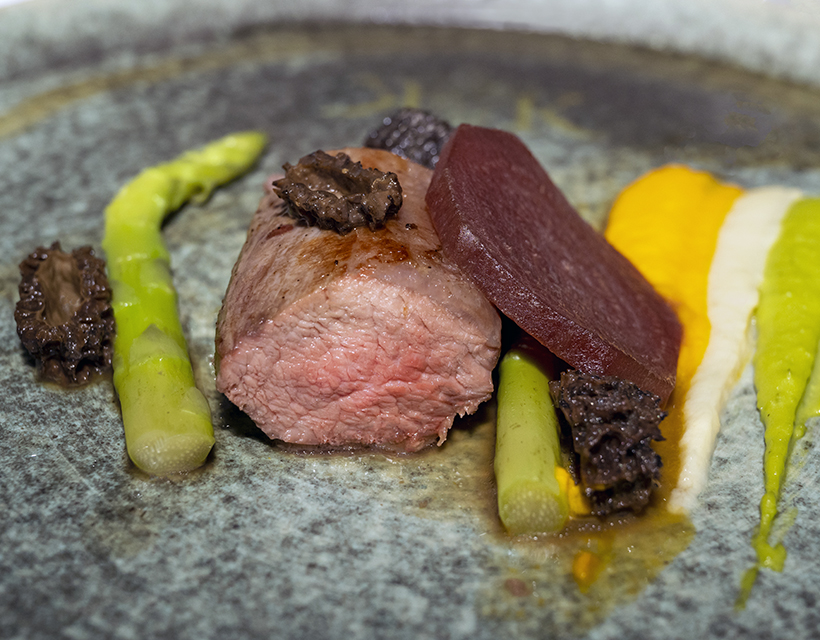
Finally, we get to try Reuben’s Reserve, vintage 2011, a selection of the best grapes from Postup and Dingač, aged in new barriques for 24-36 months, and produced only in the best harvest years. The result is much rounder and reminds me of some of the wines from Matuško (see below). The longer oak maturation makes this one a bit less fruity and more complex, with notes of chocolate.
Dessert consists of a vanilla and caramel mousse, a fluffy sponge-like carob and dark chocolate cake, and a fig cooked in whisky. It’s delicious, but a bit too small. We crave more sweets and Goran suggests we try the “ice cream” bars kept on hand for vegan customers, locally made with coconut milk, almond milk, and agave syrup. They come in two versions: white chocolate, raspberry, and cashew ice cream for the first one, dark chocolate, milk chocolate, and nuts for the second. Both delicious!
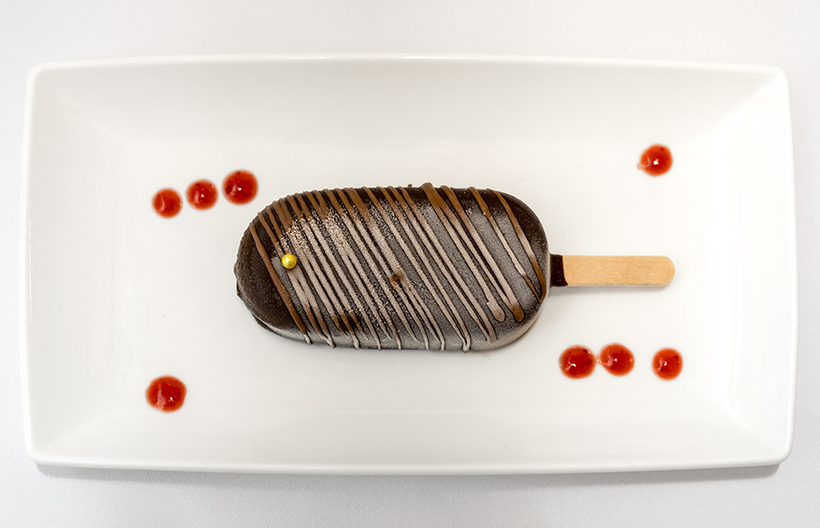
We head back to our own hotel, pleasantly full and more than a little tipsy. Korta Katarina’s wines exceeded my expectations. Except for “The American” with its excessive use of oak, I would gladly buy any of the wines we tasted. Besides, the property’s located only meters away from Plaža Trstenica, possibly the best beach in Orebić. How often do you find a good winery right next to a nice beach?
A small digression about Postup
As we’ve seen, the most respected Plavac Mali reds are made with grapes from Dingač and Postup. I’ve talked extensively about the former in my previous post; it’s time to say a word about the latter. Named after the small village that sits at its center, just to the east of Orebić, the Postup area is the eternal runner-up to Dingač. It was the second Croatian wine region to be registered for state protection, in 1967. It produces what many consider the second-best wines.
Just like Dingač, this is Plavac Mali territory, and the Postup grapes are vinified by many of the same wineries in nearby Potomje. The two microregions also benefit from a similar combination of wine-friendly soil composition, exposure, and climate, which causes some of the grapes to overripen and shrivel while still on the vine. These dried berries later produce a very concentrated juice that contributes to powerful aromatics and a high alcohol content. The Postup wines are just a little less intense than the ones from Dingač. On the flip side, the grapes are easier to harvest thanks to a more developed infrastructure, Postup being on the main road that connects Orebić to the mainland. And the wines can still be excellent, every bit as jammy (I had one with a nose of black cherries in syrup) and often with additional notes of red pepper and spice.
Postup consists of about 50 hectares of vineyards (a bit smaller than Dingač), and in a good year produces about 2,400 hl of quality wine. Somehow, it doesn’t seem that Postup has yet been awarded a European Protected Designation of Origin.

The Centenarian: Grgić
You might have heard of legendary Napa Valley winemaker Mike Grgich, who blew out his 100th candle this year, but did you know that he was born Miljenko Grgić, in Croatia? Back in the village of Desne on the Dalmatian coast, Grgić’s family had been making wine for generations and owned a small winery and vineyard. Miljenko went to the University of Zagreb in 1949 and studied all the disciplines connected to oenology, from chemistry to meteorology, in order to become a winemaker. In 1954, he decided to leave Yugoslavia “in search of freedom.”So, you guessed it: he eventually ended up in America, in the promised land of California, where he went to work for such Napa Valley pioneers as Lee Stewart and André Tchelistcheff. Eager for more responsibility, he became the chief winemaker at Robert Mondavi in 1968, then at Chateau Montelena in 1973, and he introduced some of the pioneering methods he’d learned in his previous jobs, such as malolactic fermentation. A few years later, his Chardonnay took the top spot in the white wine category at the Judgement of Paris. This new fame gave him the opportunity to create his own winery in the heart of Napa Valley, Grgich Hills Cellar, in 1977. He went on to make other top award-winning Chardonnays and even earned the moniker of King of Chardonnay.
In the 1990s and early 2000s, Grgić played an instrumental role in tracing the roots of California Zinfandel back to Croatia by supporting scientific research that collected grape samples throughout Dalmatia. In 1996, he returned to his native country and opened a new winery in Trstenik on the Pelješac peninsula. Despite his stellar Californian career, he claims that for him the most meaningful awards are the ones he’s received for his Croatian Pošip and Plavac Mali, the latter being recognized twice as the best Croatian red wine.
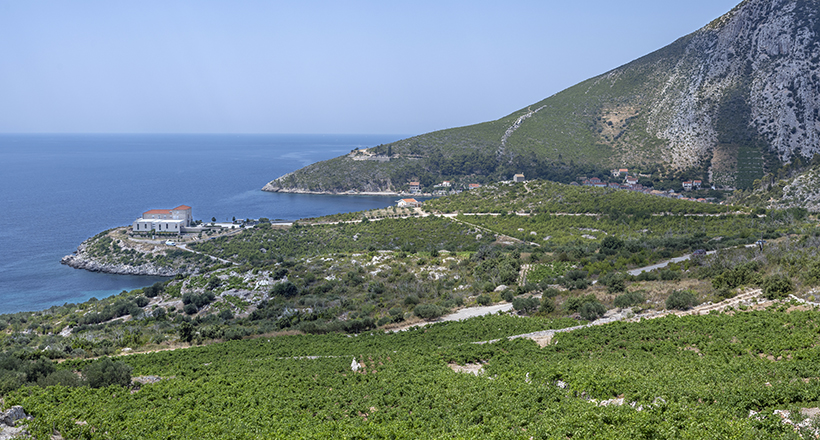
After such an amazing success story, I was quite excited by the idea of visiting the Grgić winery in Trstenik, even though more than one local had a curiously lukewarm reaction when I shared with them this particular travel plan.
And the locals had a point. I must admit it’s a bit weird that, although his family used to own a winery in a village of Southern Dalmatia where several winemakers make Pošip and Plavac Mali to this day, Grgić, the king of Chardonnay, chose to set up his new winery on the Pelješac peninsula, a region dominated by red wines where he had no family ties and where winemakers generally buy white grapes from somewhere else. As we arrive at the property, we also see no demonstration of the native-but-not-quite-local son’s excitement for his homecoming. A luxurious but austere building, isolated on a promontory outside of town, the winery is designed and sized for huge parties but seems completely empty, save for a couple workers casually drinking their own wine and largely ignoring us. Of all the tastings I’ve participated in in my life, this will prove to be the most diminutive.
During a short visit in the cellars with a guide who warmed to us eventually, it is explained that the winery owns only one little vineyard on the slopes close to the winery. The rest of their grapes are bought: Pošip from Korčula, and extra Plavac Mali from some of the higher elevation parcels of Dingač. That too is a bit strange: Grgić settled in Pelješac because it’s the best winemaking region of the country (maybe in of all of the Balkans), and he supported scientific research on Zinfandel and Plavac Mali, but didn’t bother buying parcels in the peninsula’s best appellations – he barely bothered purchasing any parcel at all. Only two labels are produced, one white and one red. And don’t expect any fancy vertical tasting: you’ll get a small sip of the latest vintage of both wines, a few store-bought crackers, and that’s it!
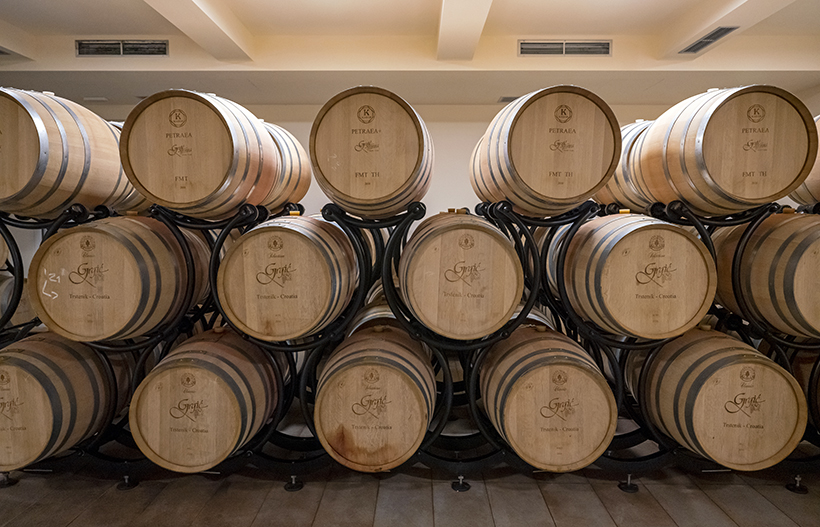
At least the wines are skillfully crafted. The Pošip is aged 30% in oak barrels, 70% in stainless steel. Just like at Korta Katarina, the mixed approach adds a bit of complexity while preserving the varietal’s characteristics, and it’s well balanced. The red wine, a 2018 vintage with 16% alcohol, is made of 80% Plavac Mali from Dingač, and 20% from elsewhere – the winery’s own vineyard nearby, I assume – and it’s aged in barriques (old and new, reused about three times) for 15 months. Having a fraction of non-Dingač grapes is actually beneficial, as it brings more balance to the wine, more acidity and a bit less fruitiness. You still find the usual notes of red berries, but the finish is slightly more tannic and the wine boasts a fuller body.
And so, two wines and a bowl of crackers later, we’re out and headed for our next visit, half-convinced that Grgić’s Croatian operation is a façade for a mysterious money-laundering scheme. It’s not that the staff isn’t friendly, it’s that the place seems to be doing the bare minimum to pass as a winery. Maybe I’m just not important enough to them. Who knows? At least there’s no chance of getting pulled over for drunk driving.
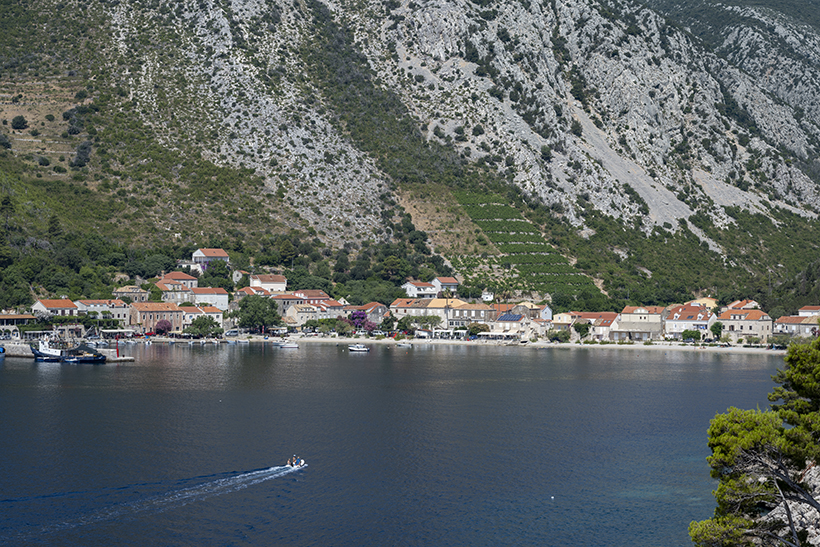
The Donkey: Matuško
Located in Potomje, Matuško Winery is named after its owner Mato Violić, who founded it in 1996. A graduate in the study of agriculture, Violić comes from a family with a long winemaking tradition (bear in mind that in Yugoslavia, the state had a monopoly on wine production, ownership of large plots was prohibited, and private winemaking was essentially a cottage industry). From a small wine cellar, he progressively expanded into an underground kingdom of 2,000 square meters with 1,000 oak barrels, and the winery became a popular destination on the peninsula. Matuško’s logo features two donkeys. As I explained in my previous post, the animals were once the most convenient way to carry the harvest from the vineyards on the remote slopes of Dingač to the other side of the hills, where the wineries are.
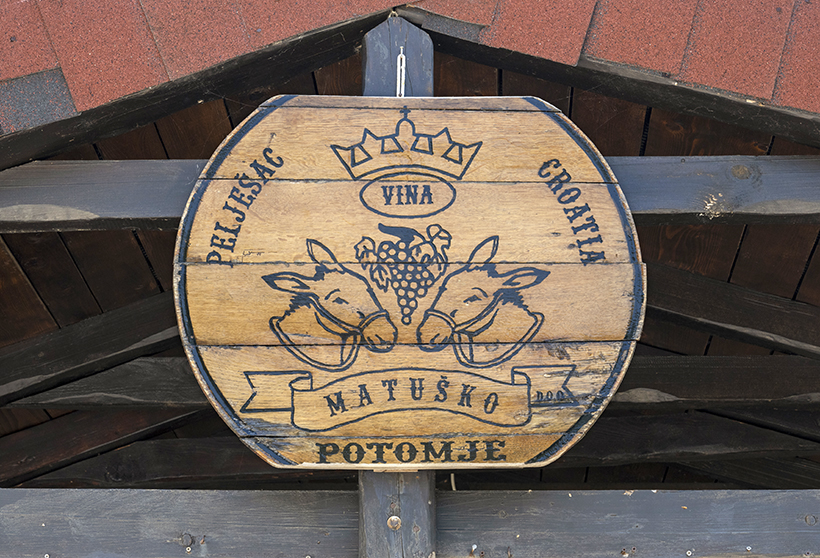
Matuško produces sparklers and white wines with Pošip and Chardonnay grapes – including a very nice Pošip aged in acacia barrels that combines the classic varietal nose of pear and citrus with hints of honey – and many different rosé and red wines made from Plavac Mali. However, I intend to focus on the Plavac Mali from Dingač, of which the winery offers four different versions. The difference between each one resides in the location of the vineyards on the slopes, the proportion of dried berries, and the time spent in oak barrels. All of them are aged in barriques from various countries: France, Spain, the USA, and Croatia.
The “regular” Dingač, vintage 2018, 14.5% alcohol, is aged in barrels for 1 year. The grapes come from vineyards at the bottom of the slope and there are no dried berries. It’s already a very good wine, low in tannins and boasting a nose of cooked berries, reminiscent of Italian Amarone. The Dingač Reserva, vintage 2013, 15% alcohol, extends the maturation to 3 years in barrels then 3 years in the bottle. The vineyards are located around the mid-point of the slope, and no dried berries are used here either. While it’s similar in style to the first one, you can taste the alcohol and it feels richer and a bit more full-bodied.
The next two wines contain some dried berries, and as you taste these wines, you definitely put them in a category of their own. The Dingač Royal, vintage 2011, contains 10-15% of the precious little raisins and the grapes come from vineyards located higher up the Dingač hillside. The wine is aged in barrels for 5 years and reaches 15.5% alcohol. It exhibits a huge concentration of aromas, with a nose and a palate of chocolate and mixed berry preserves (red berries and some darker berries, maybe blackberry). Finally, the Superior, 2010 vintage, is made in a similar style but pushes all the stats even further up, into the exceptional range. The vineyards sit on the highest part of Dingač. There are more dried berries. The wine is aged for 10 years in barriques. Alcohol clocks in at 16.2%. It’s slightly sweeter but just off-dry, and I’d still consider it a dry wine. In this tasting, I like it even better than the Royal (which our guide presented as her favorite) because it’s more unique – none of the other wineries we visited makes anything like it. On the other hand, it’s more than double the price ($90 vs $35), and while I understand why, it can be hard to justify the difference when buying. I’m also not sure this is a wine that would pair well with any kind of food; I would recommend enjoying it as an aperitif.
Matuško’s Plavac Mali wines are clearly all made in the same style, one that probably relies too much on prolonged oak barrel aging. Yet this make for an interesting tasting and some distinctive wines, and we left with more than a bottle in our arms.
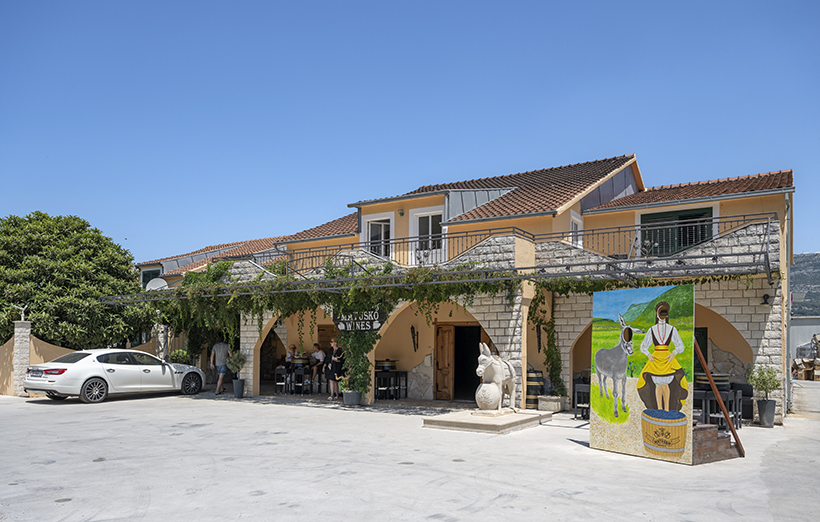
When you’re on vacation, enjoying the views of the beautiful Dalmatian coast in summer and being served without having to leave your chair, it’s easy to enjoy drinking almost anything. But what happens when you get home with your bottles and sip your wine in your tiny city apartment on a rainy day? Find out in my next post!

